AMD Launches Ryzen Embedded 5000: Vermeer for the Embedded World
AMD's Vermeer sneaks into embedded applications.

AMD on Thursday introduced its Ryzen Embedded 5000-series processors that bring its codenamed Vermeer processors in AM4 packaging to performance-hungry embedded applications. The CPUs will sit between Zen 3-based Ryzen V3000 with up to eight cores and EPYC Embedded 7000 series with up to 64 cores.
AMD's Ryzen Embedded 5000-series family of processors consist of four Vermeer CPUs with six, eight, 12, and 16 cores. The CPUs offer 32MB or 64MB of L3 cache, 24 PCIe 4.0 lanes, a dual-channel DDR4-3200 memory subsystem, and are rated for a 65W, 100W (the model 5800E can be configured for a 65W or a 100W TDP), or a 105W TDP. All of them come in an AM4 form-factor.

"The AMD Ryzen Embedded 5000 strikes an optimal balance of power and performance for applications ranging from small-form factor embedded systems to storage, security, and networking systems, suiting the broadest range of customers and use cases," said Kevin Krewell, principal analyst at TIRIAS Research in an AMD press release.
As far as silicon is concerned, the Ryzen Embedded 5000-series processors use the same Vermeer die as the Ryzen 5000 and Ryzen Pro 5000 CPUs. Meanwhile, the produces support reliability, availability and serviceability (RAS) features like ECC-supporting memory subsystem as well as guaranteed five-year planned manufacturing availability. As a result, AMD's customers will be able to use Ryzen Embedded 5950E, Ryzen Embedded 5900E, Ryzen Embedded 5800E, and Ryzen Embedded 5600E through at least 2028.
It is noteworthy that AMD launches its Ryzen Embedded 5000 processors about 2.5 years after its first Vermeer CPUs were released. Embedded applications of course require maximum reliability, so rushing these CPUs to this market did not make much sense. Meanwhile, given that AMD could not get enough TSMC's N7 allocation to fulfill demand for its Zen 3-based EPYC and Ryzen processors for mainstream PCs, it probably opted to delay the launch of Zen 3-powered embedded parts for a later date.
"Ryzen Embedded 5000 processors deliver the ideal combination of performance and reliability required for 24x7 security and networking applications," said Rajneesh Gaur, corporate vice president and general manager of the embedded solutions group at AMD in the release.. "This expansion of our embedded product portfolio offers a mid-range solution that fills the gap between our low-power BGA Ryzen Embedded and our world-class EPYC embedded family for customers requiring both high performance and scalability of up to 16 cores."
It should be noted that since AMD's Vermeer processors do not feature an integrated GPU, those who are going to use Ryzen Embedded 5000-series family of CPUs will also have to use an external graphics card. Interestingly, but AMD ceased to introduce high-performance embedded GPUs quite some time ago as the company's highest-performing embedded graphics offering is the Embedded Radeon E9565 based on the Polaris architecture. While Polaris is certainly good enough for networking servers and security applications, it certainly is outdated for aerospace, gaming, and multimedia applications.
Stay On the Cutting Edge: Get the Tom's Hardware Newsletter
Get Tom's Hardware's best news and in-depth reviews, straight to your inbox.

Anton Shilov is a Freelance News Writer at Tom’s Hardware US. Over the past couple of decades, he has covered everything from CPUs and GPUs to supercomputers and from modern process technologies and latest fab tools to high-tech industry trends.
-
lmcnabney I would have loved for AMD to have gotten these out a lot sooner. I guess I am happy with my J5040 media server, but the GPU power is missed.Reply -
wbfox Reply
As they don't have an iGPU, you would be missing even more with one.lmcnabney said:I would have loved for AMD to have gotten these out a lot sooner. I guess I am happy with my J5040 media server, but the GPU power is missed. -
m3city Reply
Exactly. But these AMD embedded are a quite different "beasts". J5040 is basically a top offering from Intel for the time being, given the constrain of very little power (~10-15W). It's good enough if it has to stream multimedia without transcoding on the fly (an option for home media server like jellyfin). It can serve as home cloud (ie Nextcloud), NAS etc. AMD has similar - but more powerfull V2000, V3000 Zen based CPUs but I think these are not available for home users, and are rather for industrial applications. Hard to buy in Europe, unleass you order by tens.lmcnabney said:I would have loved for AMD to have gotten these out a lot sooner. I guess I am happy with my J5040 media server, but the GPU power is missed.
These CPUs are first of all 65W, and lack GPU. Totally different world in my opinion. I have J4005 and it does it job (although sweats when asked for work with all its 15W ;), but I would love to update it to AMD counterpart.
Most Popular



